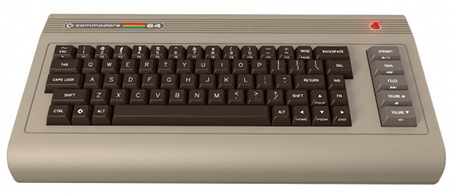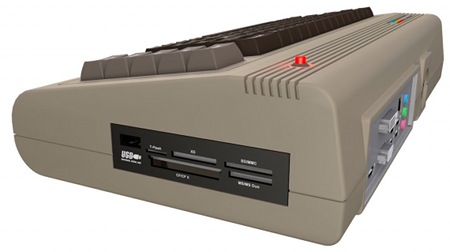Atom-powered Commodore 64 is no April Fools
Apr 5, 2011 — by LinuxDevices Staff — from the LinuxDevices Archive — 45 viewsWhile it looks like a leftover April Fools joke, a 21st century revamp of the classic Commodore 64 computer is orderable now and will ship with Linux. Equipped with a classically styled case and “color-matched” keys, the device offers a dual-core Intel Atom processor, an Nvidia Ion 2 GPU, up to 4GB of RAM, dual SATA ports, and a Mini PCI Express slot, says Commodore USA LLC.
Commodore's 64 was an 8-bit home computer that was introduced in 1982, was sold until 1994, and is said to have become the best-selling single personal computer ever. The device's chunky all-in-one casing housed 64KB of RAM and 320 x 200 pixel graphics capabilities, but storage was via a cassette drive or externally connected floppy disk.

The new Atom-powered Commodore 64
(Click to enlarge)
The "brand new" Commodore 64 (above) is intended to send buyers of a certain age into nostalgic reveries. "As close to the original in design as humanly possible," it offers styling that faithfully apes the original, the same brown-beige color, and keys with a familiar shape and layout.
According to trademark licensee Commodore USA LLC, the new C64 also has a customized operating system that allows "playing all 8-bit-era games within seconds," thanks to an emulator that can be selected from the device's boot menu. This emulator includes game ROMs, screenshots, descriptions, and ratings, the company adds.

The rear of the new Commodore 64 reveals an internal Mini-ITX board
(Click to enlarge)
Apart from the above, the device is a Windows-compatible PC that also ships with an installable copy of Ubuntu Linux. The computer combines Intel's dual-core Atom D525 processor with an Nvidia Ion 2 GPU (graphics processing unit), says Commodore. It features a Mini-ITX CPU board, visible above, along with an NM10 I/O controller and up to 4GB of DDR3 RAM, the company adds.
According to Commodore, the new C64 has room for two internal SATA II hard disk drives, while the left side of the device sports an optional drive that will come in either DVD or Blu-ray versions. The right side (below), meanwhile, has one USB slot plus microSD, XD, SD/MMC, MS/MS Duo, and CompactFlash card readers.

Instead of a cassette drive, the new C64 has memory card slots
(Click to enlarge)
The coastline of the Mini-ITX board provides the C64 with two PS/2 ports, four USB 2.0 ports, an Ethernet port, audio I/O, plus three video outputs: HDMI, VGA, and DVI-D. Internally, there's a Mini PCI Express slot for a wireless LAN adapter, plus headers for an RS232 port, two additional SATA II connectors, and 8-bit GPIO, Commodore adds.
Commodore did not release the new C64's weight or dimensions. However, the device appears to be much the same size as the original, which reportedly measured approximately 15.9 x 8 x 2.75 inches.
Commodore USA's website also touts three other devices: the Amiga 1000, Amiga 2000, and Amiga 3000. Apparently related in name only to Commodore computers of the past, these are cases designed to accept microATX or ATX motherboards, according to the company.
Availability
Commodore USA says it is now accepting orders for the C64 and will deliver the devices between mid-May and early June. Prices range from $595 for a model with 2GB of RAM and a 160GB hard disk drive, to $895 for a version with a Blu-ray drive, a 1TB hard drive, an 802.11b/g/n adapter, and Bluetooth.
The Commodore OS 1.0, with emulation functionality and classic game package, will be "mailed to purchasers when available," the company adds.
More information may be found on the C64 product page and the Commodore USA online store.
Jonathan Angel can be followed at www.twitter.com/gadgetsense.
This article was originally published on LinuxDevices.com and has been donated to the open source community by QuinStreet Inc. Please visit LinuxToday.com for up-to-date news and articles about Linux and open source.